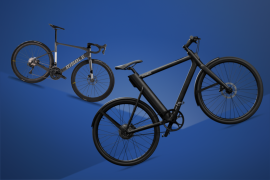Bomb Rush Cyberfunk review: just can’t get enough
This spiritual successor to Jet Set Radio has all the right moves

23 years ago, back in the summer of 2000, Jet Set Radio changed the face of gaming forever. Okay, we’re exaggerating a bit; it certainly didn’t do the numbers to save Sega’s doomed Dreamcast games console. Still, its pioneering cel-shaded visuals, anti-authoritarian attitude, and killer soundtrack cemented it as an influential cult classic. So why did the series end with original Xbox sequel Jet Set Radio Future?
Thank goodness then for Dutch indie developer Team Reptile, who has taken upon itself to make Bomb Rush Cyberfunk – a game that genuinely strives to continue JSRF’s legacy two decades later and shows Sega how to get it done.
Got them moves, got them vibes


Bomb Rush Cyberfunk absolutely nails the JSRF vibe, right down to its cartoony cel-shading. Compared to this year’s Hi-Fi Rush, everything has a deliberately more rudimentary look, almost as if this was made circa Dreamcast and Xbox’s early noughties era. There is some new tech, though, like mo-cap for a lot of the dances you see. Fun fact: some of ’em are performed by game director Dion Koster.
As a spiritual sequel, it plays much like JSRF. You’re part of a graffiti crew looking to leave your mark on the city of New Amsterdam by challenging rivals gangs and covering the city with your graffiti; gradually that draws the ire of law enforcement, who take what we’ll politely describe as disproportionate force to try and arrest you. But Bomb Rush Cyberfunk also builds on what a sequel to JSRF should be: instead of just inline skates, the main character Red actually uses a skateboard, while another character Tryce rides a BMX. You can also change their modes of traversal at your crew’s hideout, and they can also just walk on foot – though when you hit a slope or rail, they’ll automatically get their wheels on.
Graffiti tagging is closer to the original JSR’s more tactile mechanic, except you now draw lines at matching nodes. Different combinations result in different graffiti tags. It all feels intuitive, and even if you don’t memorise the patterns for any specific tag, just spinning the analog stick until something lines up still feels cool. Time also freezes when you’re tagging, so you won’t get interrupted by the fuzz.
Retro-futuristic gadgets, such as a boostpack that boosts your speed but also works as a double-jump for platforming, mix up traversal, while the mini-map is consigned to a flip phone (see how it’s keeping with the early noughties vibe). It’s operated with the D-pad, so can be kept open even as you ride around the city.
Graffiti writer not a fighter


It might lack the charismatic narration of JSR’s DJ Professor K, but Bomb Rush Cyberfunk puts a surprising focus on story. The DJ you encounter here, DJ Cypher, is the polar opposite, making his rep known by decapitating your protagonist with his sharp vinyl within the first 10 minutes. You’re quickly brought back to life with a replacement cyberhead, and sent on a mission to not just take over the city with your new crew but to try and recover your head.
The cut scenes are more than we anticipated when we’d rather just get on with painting the town with graffiti. The prologue, a linear prison escape sequence set at night, arguably doesn’t make the best first impression, not least because we’re also forced into a combat sequence that has you using your traversal and trick mechanics to fight enemies in a pretty clumsy fashion.
These are fortunately infrequent, and the core challenges still focus on facing off against rival members through non-violent skills. Your Rep increases as you tag more of each city district, gradually unlocking new challenges against gang members until you’ve amassed enough to force a crew showdown, overseen by a group of respected elders. These Oldheads act as literal gatekeepers, letting you pass through certain sections of town after you’ve gained even higher Rep.
It’s during these showdowns that you appreciate how Bomb Rush Cyberfunk also takes a leaf from Tony Hawk’s Pro Skater as you can actually perform tricks and combos, which were more of an afterthought in JSR/JSRF. Tricks are easy to perform with any of the face buttons, while you can lean the stick to make hard corners on grinding rails for boosts. The real mastery comes from keeping a combo going by landing Manuals on the ground, and quickly refilling the combo gauge with Trick Boosts. Ultimately, it’s all about staying fresh and mixing up a variety of tricks that will land you the highest scores.
Where’s your head at


The city’s architecture has been designed in a way to really test your traversal skills. After looking around the first area Versum Hill for just a few moments, you’ll see tags that are just out of reach with no obvious route to collect them, encouraging you to really explore each district.
It can at times test your patience when it transpires some harder-to-reach tags aren’t optional, leaving you short of the necessary Rep to progress the mission. Many levels are built with a great deal of verticality, but we sometimes found ourselves circling routes over and over trying to figure out how to get higher. Of course, once you’re high up, you’re still at the risk of a platforming mishap that’ll send you all the way back down to the bottom. That’s part and parcel of Bomb Rush Cyberfunk’s old-school design, which also includes going through a deliberately manual interaction to switch characters.
But reaching a new part of the city is in itself as satisfying as collecting a new graffiti design you’ve been trying to nab from a spot way high up after tens of attempts, just as it is completing challenges where you’re trying high-five a set number of robots without dropping your combo.
Any repetition is also alleviated by the bounciest soundtrack you’ll listen to in any game this year, with playlists cycling from hip-hop to lo-fi beats to buzzing electro. It’s every bit as infectious as JSRF’s soundtrack, especially as that game’s legendary composer Hideki Naganuma has also contributed three tracks, including de facto victory fanfare ‘Get Enuf’, which, well, we just can’t get enough of.
It also means that once the story’s wrapped, it’s very easy to just follow the remaining objective to just ‘hang out’ and continue soaking up New Amsterdam’s vibes, tagging everything else that you can. We did wish it was possible to do this without the cops continuing to be on our tail, which really does escalate on a GTA-style star rating to ridiculous levels (snipers, riot police, drones, all over some graffiti?!), which also does have an impact on the Switch’s performance. But then as one character declares, “Graffiti would be hella boring if it was legal!”
Bomb Rush Cyberfunk verdict


Team Reptile has done something special here with Bomb Rush Cyberfunk, proving it does not only understand the Concept of Love but knows how to smartly build upon it, essentially giving us the Jet Set Radio Future 2.0 fans of the cult series have been waiting more than two decades for.
It may come with some of the same quirks and frustrations of Sega’s original games that may chafe against modern game expectations, though new mechanics do go some way to alleviate the lows. But when the vibe is matched so strongly, it becomes very easy to forgive the bumps and just go with the flow, head unconsciously bouncing to those infectious beats, until you just can’t get enough.
Stuff Says…
The funkiest game of the summer that builds on Jet Set Radio Future’s foundations to be its own fresh cut.
Good Stuff
Funky vibes
Banging tunes for days
Fun to master tricks and combos
Bad Stuff
Some platforming frustrations
Underwhelming combat
Cops have no chill



